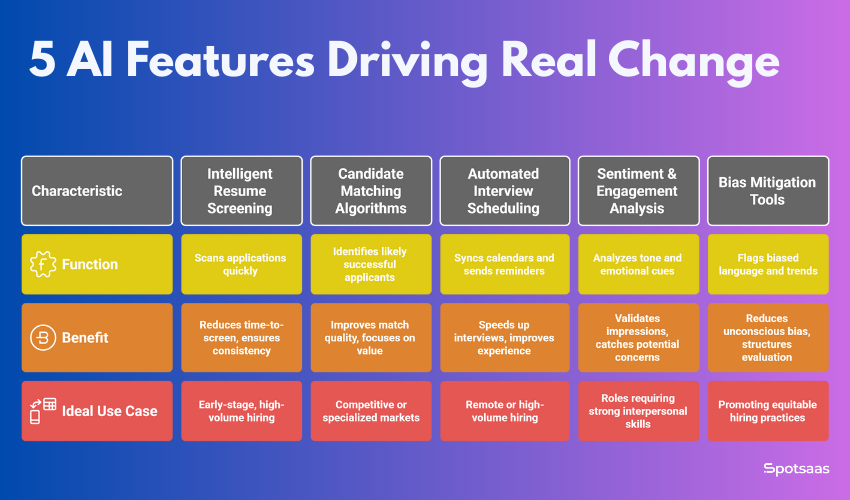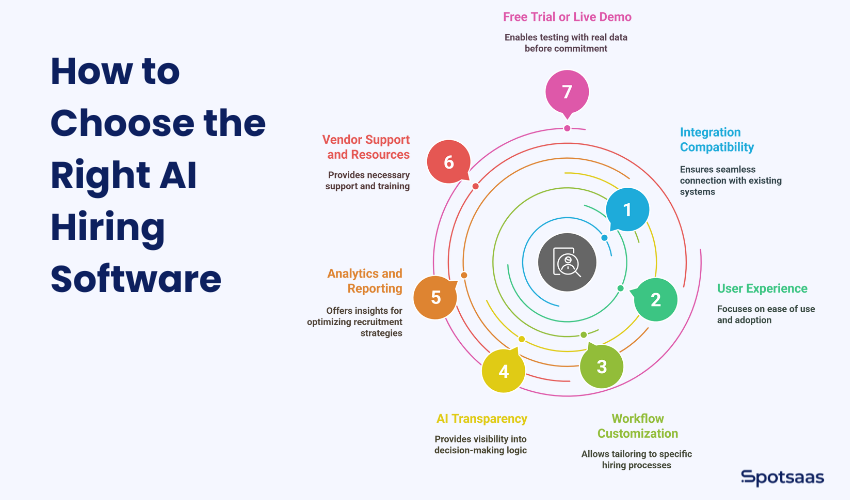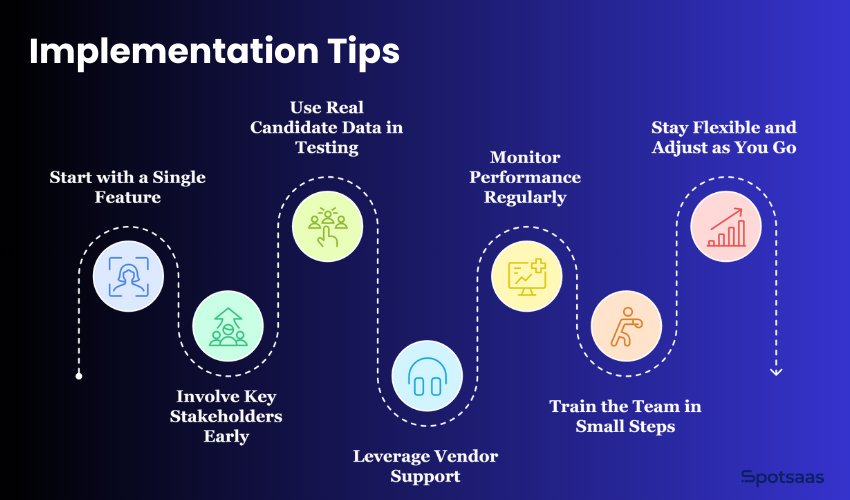Hiring today is no longer about scanning resumes manually or relying on gut instinct. Behind the scenes, AI is making a noticeable difference—quietly streamlining tasks that once took hours and adding precision to every stage of recruitment. From sourcing to scheduling, AI is helping hiring teams work faster and more accurately without overhauling their entire workflow.
Applicant Tracking Systems (ATS) have evolved. What started as simple resume databases now include smart algorithms that can screen, match, and even help reduce bias—all with minimal human intervention. This shift isn’t just for enterprise giants; companies of all sizes are adopting these tools to stay efficient and competitive.
What This Blog Includes
- A quick overview of 5 AI features transforming hiring workflows
- Insights into who benefits most from each feature—recruiters, HR teams, or growing startups
- Measurable improvements these tools bring to speed, accuracy, and candidate experience
- A pros and cons table to weigh value vs. limitations
- Real-world examples showing how teams are applying these features
- Answers to common questions hiring teams ask about AI in recruitment
- A practical checklist to help you choose the right AI-powered software
In this blog, we’ll explore five AI-powered features that are actively reshaping how teams hire. No fluff, just practical use cases that show where AI is making a real impact—and how your team can benefit.
Why AI in Hiring Is Gaining Traction
Hiring isn’t what it used to be. Teams are juggling tight deadlines, an overwhelming number of applications, and the growing need to hire fairly and fast. Manual methods like sorting through resumes or coordinating interviews can’t keep pace, and that’s exactly where AI makes a difference.
Instead of replacing recruiters, AI tools work in the background to handle repetitive tasks. Whether it’s ranking candidates based on skill match or identifying red flags in applications, AI helps teams act quickly and confidently.
Here’s what’s pushing more companies to adopt AI in recruitment:
- High-volume hiring: AI filters thousands of resumes in minutes.
- Bias reduction: Algorithms help minimize unconscious bias in screening.
- Resume fatigue: Automated tools surface top-fit candidates without guesswork.
- Scheduling overload: Smart calendars handle interview coordination instantly.
For hiring teams aiming to stay competitive, AI isn’t optional anymore—it’s becoming essential.
5 AI Features Driving Real Change

Intelligent Resume Screening
AI-powered resume screening tools can scan hundreds—or even thousands—of applications in a fraction of the time it takes a recruiter. These tools analyze factors like job titles, skill keywords, education, and years of experience to score and rank candidates automatically.
This drastically reduces the time-to-screen while ensuring that strong candidates don’t slip through the cracks. It’s beneficial in early-stage hiring when teams are overwhelmed with volume. More importantly, it brings consistency to the shortlisting process, minimizing human errors and unconscious filtering.
Candidate Matching Algorithms
These algorithms go beyond static keyword filters. They analyze patterns in successful hires, job role requirements, and candidate profiles to identify applicants who are likely to perform well, not just those who look good on paper.
This is ideal for companies hiring in competitive or specialized markets where the right fit isn’t always obvious. Over time, these systems learn from hiring outcomes, helping you continuously improve match quality. It shifts the focus from volume to value by surfacing candidates who align with both the job and company culture.
Automated Interview Scheduling
Chasing down candidates and internal teams for available time slots can slow down hiring and frustrate everyone involved. AI tools automate this process by syncing with calendars, suggesting mutually available times, and even sending reminders to reduce no-shows.
They support multiple time zones and adjust for scheduling conflicts without the recruiter lifting a finger. This speeds up the interview process while improving the candidate experience, especially for remote or high-volume hiring environments where scheduling is a major bottleneck.
Sentiment & Engagement Analysis
Some modern AI tools go beyond the resume and analyze how candidates express themselves in interviews, looking at tone, confidence, enthusiasm, and emotional cues. These insights help recruiters understand not just what a candidate says, but how they say it.
It’s useful when evaluating roles that require strong interpersonal skills or customer-facing communication. While it’s not a replacement for human judgment, this layer of behavioral intelligence can help validate impressions or catch potential concerns early in the process.
Bias Mitigation Tools
AI can support more equitable hiring by flagging biased language in job descriptions and analyzing trends in applicant progression. For example, if certain demographics consistently drop off at the same stage, the system can alert hiring teams to investigate further.
These tools also help structure evaluation criteria around role-specific requirements rather than subjective preferences. By encouraging consistent, data-backed decisions, AI helps reduce the influence of unconscious bias, without requiring a complete process overhaul.
Who Uses These Tools?
AI-powered hiring features are not just for big corporations. They’re being used across industries and company sizes—from growing startups to global enterprises—each with their own goals for improving efficiency, fairness, or candidate experience.
🧑💼 Recruitment Teams
Automate screening and scheduling to free up time for strategic hiring efforts and candidate relationships.
🏢 HR Departments
Create consistency across departments with structured workflows and smarter evaluation tools.
🚀 Startups & Scaling Teams
Accelerate hiring cycles and reduce manual workload—perfect for lean teams competing for top talent.
🏦 Enterprise Organizations
Handle high-volume hiring at scale with centralized dashboards, automation, and actionable insights.
🤝 Hiring Agencies
Quickly match candidates to diverse client needs using AI-powered recommendations and shortlists.
Recruitment Teams
Recruiters often manage dozens of roles at once, each with its own timeline and set of expectations. AI tools help them prioritize the best-fit applicants, automate screening tasks, and handle scheduling without needing to juggle spreadsheets or inbox overload. With AI doing the heavy lifting, recruiters can focus more on strategic tasks, like building relationships with high-potential candidates.
HR Departments
For HR professionals managing end-to-end employee journeys, AI simplifies early-stage hiring tasks while improving consistency across roles and departments. These tools allow HR to standardize processes like resume evaluation or interview scoring. The result is a more structured approach to hiring that scales well as the company grows, ensuring quality and compliance along the way.
Startups and Scaling Companies
Startups can’t afford to make bad hires or lose time in drawn-out processes. With limited staff and resources, AI tools help them compete with larger companies by speeding up hiring cycles and surfacing better candidates faster. Many platforms are affordable and flexible, making them ideal for fast-growing teams that need results without complex setup.
Enterprise Organizations
In larger companies with hundreds of open roles, AI tools bring much-needed clarity to high-volume workflows. They help maintain consistency across teams, improve collaboration among stakeholders, and deliver insights at scale. Whether hiring across departments or geographies, these tools bring structure and speed without compromising on quality.
Hiring Agencies
Staffing firms and recruitment agencies juggle multiple clients with diverse needs. AI features allow them to sift through candidate pools quickly, match profiles to various roles, and deliver shortlists that are accurate and timely. These tools become a competitive advantage, enabling agencies to place top talent faster and more efficiently.
Pros and Considerations
| Pros | Considerations |
|---|---|
| ✅ Speeds up screening and shortlisting process | ❌ May require some training for teams new to AI |
| ✅ Improves quality-of-hire by surfacing better-fit candidates | ❌ Candidate sentiment analysis can be misread without context |
| ✅ Automates repetitive tasks like scheduling and follow-ups | ❌ Some tools may be costly for very small teams |
| ✅ Helps reduce unconscious bias in screening decisions | ❌ Requires oversight to avoid over-reliance on algorithms |
| ✅ Offers insights and analytics to refine hiring strategies | ❌ Effectiveness depends on quality of input data |
Real-World Use Cases
- Retail company speeding up seasonal hiring
A national retailer used AI resume screening and automated scheduling to cut their seasonal hiring time in half—moving from 10 days to under 5 days per candidate. - SaaS firm finding culture-fit engineers.
A growth-stage SaaS company implemented candidate matching algorithms to identify engineers who aligned with both technical requirements and company values, improving retention after 90 days. - A healthcare organization avoids scheduling delays.
A large healthcare network integrated AI-powered interview scheduling to reduce coordination time across departments, ensuring faster hiring for critical patient-facing roles. - Remote-first startup reducing candidate dropout
A remote-first team used sentiment analysis and engagement tracking to better gauge candidate interest and reduce early-stage ghosting during the hiring process.
How to Choose the Right AI Hiring Software
With so many AI-powered hiring tools available, picking the right one can feel overwhelming. But it doesn’t have to be. The key is to focus on features that actually support your team’s day-to-day needs, not just what looks impressive in a demo.

When evaluating platforms, consider:
Integration Compatibility
Does the platform plug into your existing tech stack? Look for tools that integrate smoothly with your current Applicant Tracking System (ATS), Human Resource Information System (HRIS), calendar apps (like Google or Outlook), and communication tools (such as Slack or Teams). The fewer manual workarounds, the better.
User Experience
Ease of use is often underestimated. A clean, intuitive interface makes a big difference in team adoption. If recruiters and hiring managers can’t figure out how to use the tool within the first 15 minutes, it’s likely going to slow things down rather than speed them up.
Workflow Customization
Every company has its own approach to hiring—some need structured scorecards, others rely on more flexible evaluations. The ideal software should let you customize workflows, interview stages, resume scoring rules, and candidate matching criteria based on your hiring style.
AI Transparency
AI shouldn’t feel like a black box. Make sure the tool explains how it’s evaluating or ranking candidates. Platforms that offer visibility into decision-making logic help build trust and make it easier for teams to justify their choices during internal reviews.
Analytics and Reporting
The best ATS tools do more than automate—they inform. Look for platforms that provide visual dashboards and detailed reports on time-to-hire, candidate conversion rates, hiring funnel drop-offs, and diversity metrics. These insights help you continuously optimize your recruitment strategy.
Vendor Support and Resources
Even the best tool won’t succeed without the right support. Choose a vendor that offers responsive onboarding, live demos, video tutorials, and ongoing account management. Bonus points if they provide templates, training for hiring managers, or onboarding checklists that save you time.
Free Trial or Live Demo
Before you commit, see how the tool performs in a real-world scenario. A live demo using your own candidate data can reveal whether the software actually fits your workflow—and help you identify any hidden limitations before signing a contract.
Choosing the right AI hiring tool isn’t about finding the most advanced software—it’s about finding the one that fits your team’s needs, scales with your growth, and makes your hiring process faster, smarter, and more consistent.
Most importantly, look for platforms that offer a free trial or live demo using real candidate data. This lets you see how the software performs in your actual workflow, before committing.
Implementation Tips
Rolling out AI-powered hiring tools might sound like a significant change, but with the right approach, it can be smooth, low-risk, and even energizing for your team. Most modern platforms are built to integrate quickly, work alongside your current tools, and support gradual adoption. Here’s how to make that transition seamless and successful:

Start with a Single Feature
Begin by selecting one high-impact feature, such as resume screening, candidate matching, or interview scheduling. Focusing on just one use case allows your team to test the tool in a real environment, evaluate performance, and build confidence before expanding further. This staged rollout prevents overwhelm and makes it easier to demonstrate early wins.
Involve Key Stakeholders Early
Bring recruiters, hiring managers, and IT into the process from day one. Their input is invaluable in shaping how the tool fits into existing workflows. When stakeholders feel like part of the decision, they’re more likely to support adoption and champion the tool internally. Early involvement also helps uncover specific needs or constraints that might influence the setup.
Use Real Candidate Data in Testing
A tool that looks great in a generic demo may not perform the same way in your actual hiring funnel. That’s why it’s critical to test with real data from current or recent job openings. This lets you observe how the software handles your candidate volume, hiring criteria, and evaluation steps, giving you confidence that it will deliver the results you need.
Leverage Vendor Support
Don’t go it alone. Most AI hiring platforms offer onboarding support that ranges from self-serve tutorials to full implementation assistance. Take advantage of these resources—ask for templates, onboarding playbooks, or guided sessions for hiring managers. Good vendors are invested in your success and will help smooth out technical or training-related hiccups.
Monitor Performance Regularly
Once the tool is live, track key metrics to understand its impact. Review analytics weekly or monthly to identify trends, inefficiencies, or improvements. Metrics like time-to-hire, candidate drop-off rates, or feedback from hiring managers can help you optimize the tool’s use and fine-tune your hiring strategy.
Train the Team in Small Steps
Not everyone needs a full training session. Create quick guides or short video walkthroughs for different roles—what recruiters need to know will differ from what a hiring manager uses. Emphasize the benefits to each role rather than just explaining how the software works. The goal is to make every user feel confident, not overwhelmed.
Stay Flexible and Adjust as You Go
As with any new process, be open to iteration. You may discover that some workflows need tweaking or that one feature delivers more value than expected. Regular feedback loops between users and HR leaders can help fine-tune how the tool is applied and ensure it continues to meet your evolving hiring needs.
By starting small, staying strategic, and involving your team early, you’ll unlock the benefits of AI without disrupting what’s already working. The right approach turns implementation from a technical upgrade into a long-term competitive advantage.
Buyer’s Checklist: AI Hiring Software
Use this checklist during product demos, internal discussions, or while comparing platforms side-by-side. It’s designed to keep the focus on functionality, usability, and long-term value.
Core Features
- Supports resume screening, candidate matching, and interview scheduling
- Offers AI tools for engagement tracking or sentiment analysis
- Includes bias detection or fairness insights in candidate evaluation
Integration & Compatibility
- Syncs with existing ATS, HRIS, calendar tools, and communication platforms
- Supports SSO or role-based access for hiring teams
- Provides API or Zapier connections for custom workflows
Usability & Customization
- Easy to use without deep technical knowledge
- Allows workflow adjustments to match your hiring process
- Enables customizable scoring or evaluation criteria
Support & Setup
- Includes onboarding support, tutorials, or a knowledge base
- Offers live chat, email, or a dedicated account manager
- Available documentation or templates for quick rollout
Insights & Reporting
- Provides analytics dashboards for team performance and hiring metrics
- Tracks diversity or bias indicators (if required)
- Helps measure improvements in time-to-hire or quality-of-hire
Trial & Scaling
- Offers a free trial or live test with real data
- Scales easily for growing hiring needs
- Transparent pricing with flexible plans
Conclusion
AI in hiring isn’t just a trend—it’s a quiet shift that’s reshaping how teams attract, evaluate, and hire top talent. By automating the repetitive and highlighting what matters most, AI tools give recruiters more time to focus on people, not just processes.
Whether you’re trying to speed up resume screening, improve interview scheduling, or reduce bias in hiring, the right software can make a measurable difference. But it’s not about finding the most advanced platform—it’s about finding the one that fits your team, solves your real challenges, and grows with you.
As you explore tools and compare features, keep your goals front and center. Start small, test with real data, and build from there. Because the future of hiring isn’t just brighter, it’s already here.
Frequently Asked Questions
What is AI hiring software?
AI hiring software uses machine learning to automate and improve parts of the recruitment process, like screening, matching, and scheduling.
Can AI replace recruiters?
No, it supports recruiters by handling repetitive tasks, not replacing the human element of hiring.
Is it hard to implement AI in hiring?
Most tools are plug-and-play and come with onboarding support, making setup simple.
Are AI hiring tools suitable for small teams?
Yes, many platforms offer flexible pricing and features designed for startups and growing teams.
What’s the most significant benefit of using AI in hiring?
It saves time, improves the quality of hire, and adds consistency across the hiring process.





